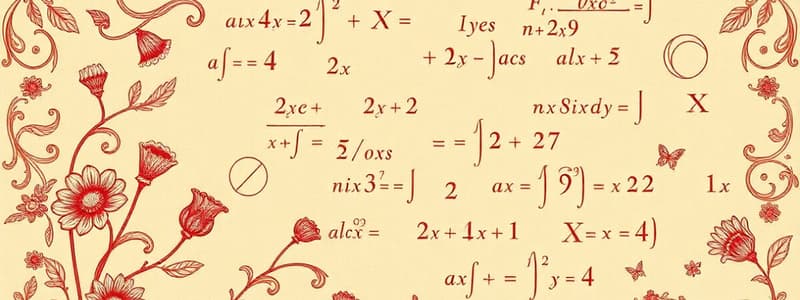Podcast
Questions and Answers
What is the general form of a quadratic equation?
What is the general form of a quadratic equation?
- a²x + bx + c = 0
- ax² + bx + c = 0 (correct)
- ax + bx + c = 0
- ax² + b + c = 0
Which of the following methods can be used to solve quadratic equations?
Which of the following methods can be used to solve quadratic equations?
- Factoring and completing the square (correct)
- Substitution only
- Simple addition
- Graphing only
What does the function notation f(x) represent?
What does the function notation f(x) represent?
- The output for a specific input x (correct)
- The average of all outputs
- The maximum value of the function
- The input value used in the function
What is NOT a key characteristic of functions?
What is NOT a key characteristic of functions?
Which of the following accurately describes a measure of central tendency?
Which of the following accurately describes a measure of central tendency?
What is the form of a linear equation in one variable?
What is the form of a linear equation in one variable?
Which property is crucial for isolating the unknown variable in an equation?
Which property is crucial for isolating the unknown variable in an equation?
How are solution sets for linear inequalities often represented?
How are solution sets for linear inequalities often represented?
What term describes a collection of two or more linear equations with the same variables?
What term describes a collection of two or more linear equations with the same variables?
What does factoring a polynomial accomplish?
What does factoring a polynomial accomplish?
Which method is NOT a common way to solve systems of linear equations?
Which method is NOT a common way to solve systems of linear equations?
What changes the direction of the inequality sign when manipulating linear inequalities?
What changes the direction of the inequality sign when manipulating linear inequalities?
Which property of exponents is used for simplifying expressions like $x^a \cdot x^b$?
Which property of exponents is used for simplifying expressions like $x^a \cdot x^b$?
Flashcards
Factoring in Algebra
Factoring in Algebra
Breaking down algebraic expressions into simpler terms to make them easier to work with.
Quadratic Equation
Quadratic Equation
A polynomial equation of degree 2, usually having the form ax² + bx + c = 0.
Function
Function
A relationship where each input value has exactly one output value.
Function Notation
Function Notation
Signup and view all the flashcards
Line of Best Fit
Line of Best Fit
Signup and view all the flashcards
Linear Equation
Linear Equation
Signup and view all the flashcards
Solving Linear Equations
Solving Linear Equations
Signup and view all the flashcards
Linear Inequality
Linear Inequality
Signup and view all the flashcards
Systems of Linear Equations
Systems of Linear Equations
Signup and view all the flashcards
Polynomial
Polynomial
Signup and view all the flashcards
Factoring
Factoring
Signup and view all the flashcards
Solving Linear Inequalities
Solving Linear Inequalities
Signup and view all the flashcards
Exponents
Exponents
Signup and view all the flashcards
Study Notes
Fundamental Concepts
- Algebra 1 builds upon arithmetic, introducing symbolic representation of numbers and relationships.
- Variables are used to represent unknown quantities, allowing for generalisation of mathematical concepts.
- Equations and inequalities express relationships between variables and constants.
- Solving equations involves isolating the unknown variable.
- Linear equations represent a straight line on a graph.
Linear Equations
- A linear equation in one variable has the form ax + b = 0, where 'a' and 'b' are constants and 'x' is the variable.
- The solution to a linear equation is the value of the variable that makes the equation true.
- Methods for solving linear equations include addition, subtraction, multiplication, and division properties of equality.
- Graphing linear equations involves plotting points on a coordinate plane that satisfy the equation.
Linear Inequalities
- Linear inequalities in one variable have the form ax + b > 0, ax + b < 0, ax + b ≥ 0, or ax + b ≤ 0, where 'a' and 'b' are constants and 'x' is the variable.
- Solving linear inequalities follows similar principles to solving linear equations.
- Inequalities often result in solution sets represented by intervals on a number line, or in some cases, all real numbers.
- The direction of the inequality sign changes when multiplying or dividing by a negative number.
Systems of Linear Equations
- A system of linear equations consists of two or more linear equations with the same variables.
- Solving such systems involves finding values for the variables that satisfy all equations simultaneously.
- Methods for solving systems include graphing, substitution, and elimination.
- A system of linear equations can have one solution, infinitely many solutions, or no solution.
Exponents and Polynomials
- Exponents represent repeated multiplication.
- Polynomial expressions involve variables, constants, and exponents.
- Basic operations on polynomials include addition, subtraction, and multiplication.
- Laws of exponents help simplify and manipulate expressions with exponents.
Factoring
- Factoring is the process of writing a polynomial as a product of simpler polynomials.
- Factoring is used to solve quadratic equations and to simplify algebraic expressions.
- Different methods of factoring include grouping, the difference of squares, and the sum/difference of cubes.
- Factoring helps in simplifying algebraic expressions, solving equations, and finding zeros or roots of polynomial functions.
Quadratic Equations
- Quadratic equations are polynomial equations of degree 2.
- They have the general form ax² + bx + c = 0, where a, b, and c are constants and a ≠ 0.
- Solving quadratic equations involves methods like factoring, completing the square, and using the quadratic formula.
Functions
- A function is a relationship between two sets of numbers, where each input from one set is associated with exactly one output from the other set.
- Functions can be represented by equations, tables, graphs, or verbal descriptions.
- Function notation (f(x)) is used to represent the output of a function for a given input.
- Key characteristics of functions include domain and range, intercepts, maximum and minimum values and rates of change.
Data Analysis
- Representing data using graphs such as histograms, scatter plots, and line graphs.
- Interpreting data and drawing conclusions based on patterns and trends.
- Finding lines of best fit to model relationships in data using different methods.
- Calculating measures of central tendency like mean, median, and mode, and measures of spread like the standard deviation.
Studying That Suits You
Use AI to generate personalized quizzes and flashcards to suit your learning preferences.
Description
This quiz covers essential topics in Algebra 1, including the foundational concepts of symbolic representation and the use of variables. It explores linear equations and inequalities, providing methods for solving them as well as graphing techniques. Test your understanding of these key algebraic principles!





